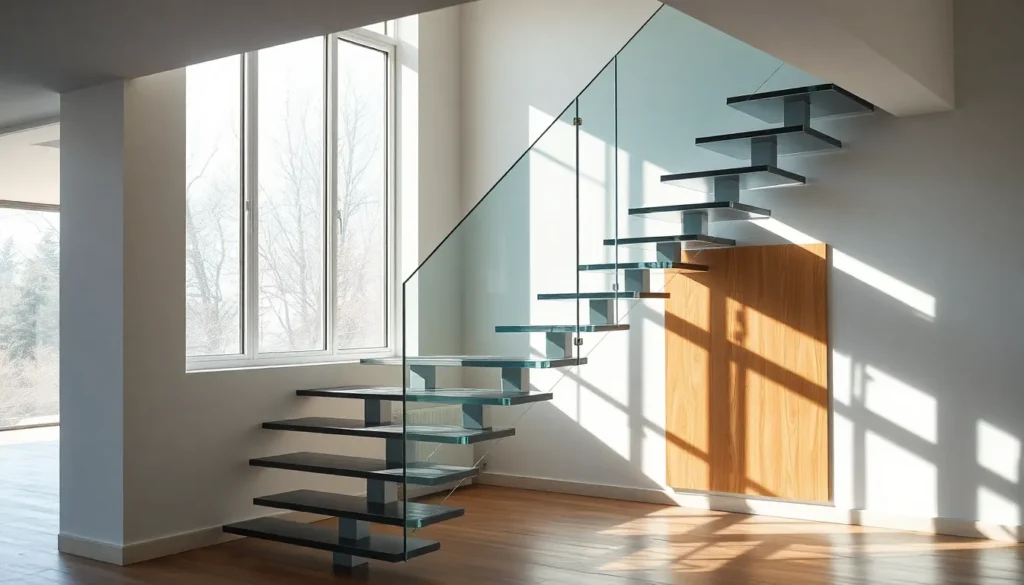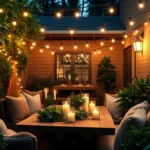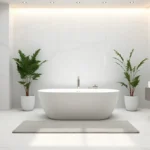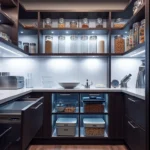Floating staircases transform ordinary homes into architectural masterpieces with their sleek minimalist design and space-saving functionality. We’ve seen these stunning structural elements become increasingly popular among homeowners who want to create a dramatic focal point while maximizing their living space.
The beauty of floating stairs lies in their ability to create an illusion of weightlessness – each step appears to defy gravity as it’s anchored to the wall without visible support brackets underneath. This design approach doesn’t just look incredible; it also allows natural light to flow freely throughout your space and makes smaller areas feel significantly larger.
Whether you’re planning a complete home renovation or simply looking to upgrade your current staircase we’ll explore the most innovative floating staircase ideas that’ll elevate your interior design game. From modern glass and steel combinations to warm wood finishes these design concepts will help you choose the perfect floating staircase that matches your style and budget.
Modern Minimalist Floating Staircase Designs
Modern minimalist floating staircase designs transform homes with their sophisticated approach to vertical movement. We’re witnessing a shift toward cleaner aesthetics that prioritize functionality without sacrificing visual impact.
Clean Lines and Geometric Shapes
Straight treads create the foundation of minimalist floating staircase design. We see homeowners gravitating toward rectangular platforms that eliminate unnecessary curves or decorative elements. These geometric forms establish visual consistency throughout the space while maintaining structural integrity.
Angular configurations define the most striking minimalist installations. Sharp 90-degree turns and precisely measured spacing between treads create architectural drama. We recommend maintaining uniform tread thickness of 2-3 inches for optimal visual balance.
Cantilever extensions showcase the true essence of floating staircase engineering. Each tread extends from the wall without visible brackets or supports underneath. The result creates dramatic shadows and emphasizes the geometric precision of the design.
Neutral Color Palettes
White and gray combinations dominate contemporary minimalist floating staircase installations. We observe that pure white treads against light gray walls create seamless integration with modern interiors. This pairing reflects natural light effectively while maintaining the illusion of weightlessness.
Natural wood tones provide warmth within minimalist frameworks. Light oak, maple, and birch offer subtle grain patterns without overwhelming the clean aesthetic. We find that blonde wood finishes complement white walls while adding organic texture to geometric forms.
Monochromatic schemes establish visual continuity from floor to ceiling. Black steel supports with matching black treads create bold statements in contemporary homes. We recommend this approach for spaces with abundant natural light to prevent the design from appearing too heavy.
Hidden Support Systems
Wall-mounted brackets disappear behind treads to maintain clean profiles. We install these steel reinforcements directly into structural walls, creating the appearance of treads floating independently. Each bracket must support 300-400 pounds according to building codes.
Invisible hardware connects treads without visible fasteners or joints. Specialized mounting systems use hidden clips and internal steel frames. We ensure these connections remain accessible for maintenance while preserving the seamless aesthetic.
Structural integration embeds support elements within walls during construction. This approach allows architects to plan floating staircase installations from the foundation up. We work with engineers to calculate load distribution and ensure proper reinforcement within wall cavities.
Industrial Floating Staircase Ideas

Industrial floating staircases bring raw sophistication to modern homes with their bold materials and exposed structural elements. These designs embrace the beauty of unfinished materials while maintaining the floating effect that creates visual drama.
Exposed Steel Framework
Exposed steel frameworks define the foundation of industrial floating staircase design. These visible structural elements showcase the engineering behind the staircase rather than hiding it. We see steel beams and supports become decorative features that add visual weight to the space.
I-beam steel stringers create the most authentic industrial appearance. These hefty structural components provide the raw, manufactured look that characterizes true industrial design. Steel frameworks often feature powder coated finishes that protect against corrosion while maintaining their bold appearance.
Structural visibility becomes an art form in industrial settings. The exposed framework allows homeowners to appreciate the craftsmanship and engineering that makes floating staircases possible. This transparency creates architectural interest while emphasizing the minimalist approach to vertical movement.
Raw Metal Treads
Raw metal treads deliver uncompromising durability for high traffic areas. These treads maintain their industrial character through their unfinished surfaces and substantial thickness. We recommend steel treads that can withstand heavy use while developing a natural patina over time.
Concrete treads paired with steel stringers create striking material contrasts. This combination offers the raw aesthetic that industrial facilities require while providing long lasting performance. Metal and concrete combinations work particularly well in monumental floating staircase designs.
Perforated metal treads add texture while maintaining the industrial theme. These specialized treads allow light to pass through while providing excellent traction. Perforated designs reduce visual weight without sacrificing the bold character that defines industrial floating staircases.
Edison Bulb Lighting Integration
Edison bulb lighting transforms industrial staircases into dramatic focal points. These vintage style bulbs complement the raw materials while providing essential illumination for safe navigation. We install Edison bulbs along the framework or beneath treads for optimal lighting distribution.
Exposed filament bulbs enhance the authentic industrial atmosphere. The warm glow from these bulbs softens the hard edges of metal and concrete materials. Edison bulb fixtures can highlight exact architectural details while maintaining the utilitarian aesthetic.
Cable railing systems often incorporate Edison bulb lighting features. These sleek systems use powder coated steel posts and aluminum top rails to support integrated lighting. The combination creates a cohesive design that emphasizes both safety and industrial charm throughout the staircase structure.
Wooden Floating Staircase Concepts

Natural wood brings warmth and sophistication to floating staircase designs while maintaining their contemporary appeal. These wooden concepts offer endless possibilities for creating striking architectural features that complement various interior styles.
Natural Oak and Walnut Options
Oak delivers exceptional durability and aesthetic appeal, making it one of the most popular choices for wooden floating staircases. This traditional hardwood provides a warm, inviting appearance that works beautifully in both contemporary and transitional homes. Natural oak’s prominent grain patterns create visual interest while maintaining a timeless elegance.
Walnut offers a darker, more sophisticated alternative that elevates any interior space. Rich chocolate tones and distinctive grain patterns make walnut floating staircases true statement pieces. Premium walnut treads develop deeper patina over time, improving their luxurious appearance and adding long term value to your investment.
Both wood species provide structural integrity essential for floating staircase applications. Oak and walnut can support important weight loads while maintaining their floating appearance when properly installed with hidden support systems.
Reclaimed Wood Aesthetics
Reclaimed wood transforms floating staircases into unique conversation pieces with distinctive character and history. Salvaged barn wood, old growth timber, and weathered planks each tell their own story through natural weathering patterns and aged textures. These materials bring authentic vintage charm that can’t be replicated with new lumber.
Environmental benefits make reclaimed wood an increasingly popular choice among eco conscious homeowners. Using salvaged materials reduces demand for new timber harvesting while giving discarded wood a second life in your home. Reclaimed floating staircases often feature interesting imperfections like nail holes, saw marks, and natural color variations that add personality.
Cost effectiveness can make reclaimed wood options more budget friendly than premium new hardwoods. Many reclaimed materials come from demolished buildings or old structures, offering high quality wood at competitive prices while supporting sustainable building practices.
Live Edge Design Elements
Live edge wood showcases nature’s organic beauty by preserving the natural bark edge and irregular contours of the original tree. Each step becomes a unique piece of functional art, displaying the wood’s natural growth patterns and distinctive grain characteristics. Live edge floating staircases create stunning focal points that celebrate natural materials.
Custom fabrication allows live edge designs to incorporate the wood’s natural curves and imperfections into the staircase structure. Skilled craftsmen work with each piece’s unique characteristics to create treads that flow seamlessly together while maintaining structural requirements. These staircases often feature subtle variations in width and shape that enhance their organic appeal.
Finishing techniques protect live edge surfaces while preserving their natural beauty. Clear protective coatings maintain the wood’s original texture and color while providing necessary durability for high traffic areas. Proper sealing prevents moisture damage and ensures your live edge floating staircase maintains its striking appearance for years to come.
Glass and Acrylic Floating Staircase Solutions
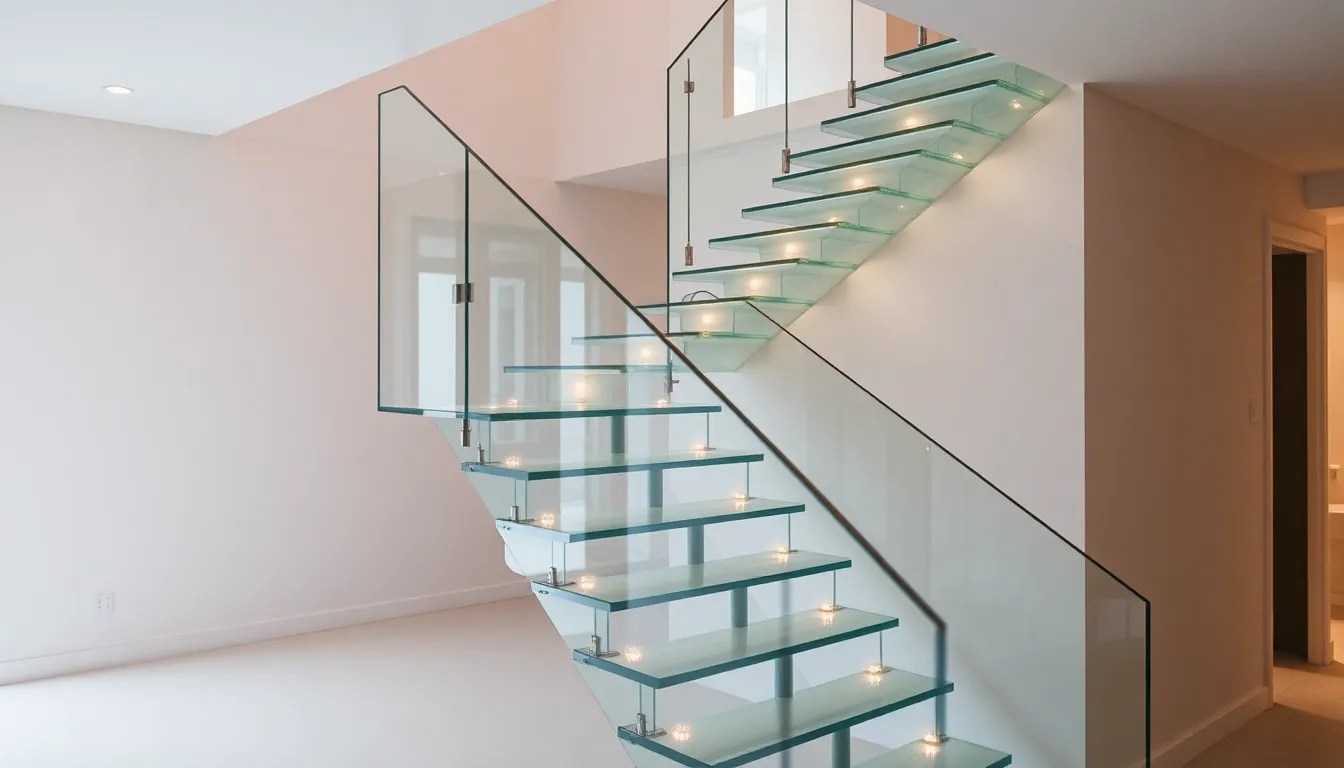
Glass and acrylic materials offer unmatched transparency and elegance for modern floating staircases. These answers create stunning focal points while maintaining the open, airy aesthetic that makes contemporary homes feel larger and brighter.
Transparent Tread Materials
Glass treads represent the pinnacle of modern staircase design with their crystal clear appearance and exceptional durability. We recommend tempered safety glass for all installations, as it provides the necessary strength while meeting safety regulations for residential and commercial applications. This material allows natural light to flow freely through each step, creating an almost invisible pathway that enhances the floating effect.
Acrylic treads deliver similar visual impact with added practical benefits that make them increasingly popular among homeowners. They’re significantly lighter than glass alternatives, reducing structural load requirements and making installation more straightforward. Cost effectiveness makes acrylic an attractive option for budget conscious projects without sacrificing the sophisticated transparency that defines modern floating staircases.
Both materials blend seamlessly with various interior styles, from ultra modern minimalism to contemporary traditional designs. Light transmission through transparent treads eliminates the visual bulk that solid materials create, making spaces appear more open and spacious. Customization options include different thicknesses and edge treatments to match exact architectural requirements and personal preferences.
LED Strip Lighting Integration
LED strip lighting transforms transparent floating staircases into breathtaking architectural features that serve both form and function. We install these strips along tread edges or within the supporting structure to highlight the floating effect while providing essential safety illumination. Edge lighting creates a dramatic outline around each step, making the transparent materials glow softly in low light conditions.
Various color options allow homeowners to customize their staircase lighting to match interior design themes or create mood lighting for different occasions. Installation within the supporting framework provides subtle uplighting that enhances safety without overwhelming the clean aesthetic. Color temperature selection ranges from warm whites that create cozy ambiance to cool whites that emphasize the modern, crisp appearance.
Functional benefits include improved visibility during nighttime navigation and automatic activation through motion sensors or smart home integration. Safety enhancement occurs naturally as each step becomes clearly defined through strategic lighting placement. Energy efficiency makes LED strips a practical long term solution that provides years of reliable illumination with minimal maintenance requirements.
Safety Glass Railings
Safety glass railings complete the transparent aesthetic while ensuring user protection and building code compliance. Tempered glass construction provides the necessary strength to withstand normal use and accidental impacts, making these railings both beautiful and functional. We prefer frameless fittings and minimal hardware to maintain the floating visual effect while meeting all safety regulations.
Unobstructed views remain a primary advantage of glass railings, allowing sight lines to flow freely throughout the space without visual barriers. Modern hardware options include nearly invisible mounting systems that seem to suspend the glass panels without visible support. Thickness selection depends on height requirements and local building codes, typically ranging from standard residential to commercial grade specifications.
Customization opportunities include frosted or etched patterns for added privacy while maintaining the transparent quality. Hardware finishes can match other architectural elements, from brushed stainless steel to powder coated options in various colors. Maintenance requirements remain minimal with regular cleaning using standard glass care products to preserve clarity and appearance.
Curved and Spiral Floating Staircase Designs
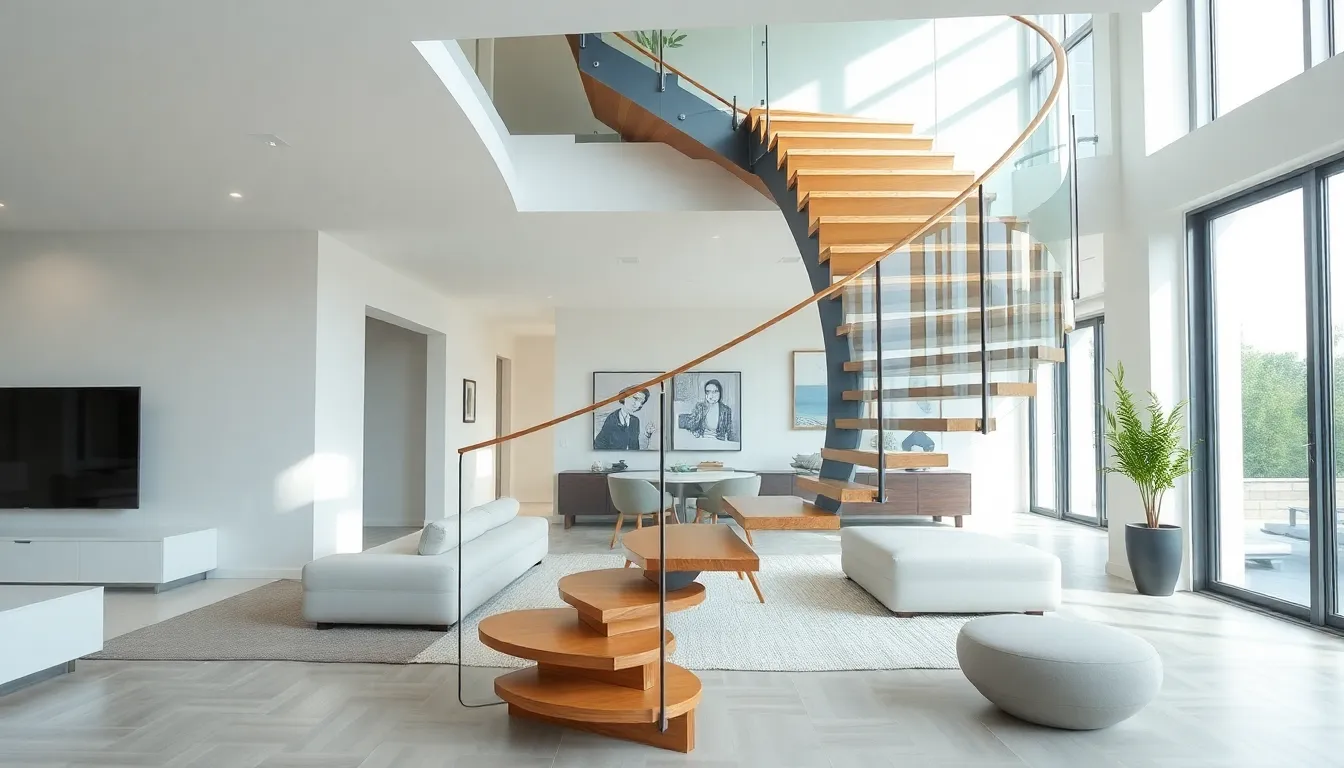
Moving beyond straight lines, curved and spiral floating staircases transform vertical circulation into sculptural statements that redefine architectural spaces. These designs challenge traditional staircase concepts while maintaining the weightless aesthetic we’ve explored in minimalist and transparent options.
Helical Support Structures
Helical staircase supports revolutionize floating stair engineering by combining structural necessity with dramatic visual impact. Steel helical frameworks create twisting support columns that spiral upward while maintaining the illusion of floating treads. Acrylic helical supports offer a contemporary alternative that blends transparency with curved elegance, allowing light to pass through while providing essential structural integrity.
We’ve observed that custom helical structures require precise engineering calculations to balance aesthetic curves with load bearing requirements. Modern fabrication techniques enable these supports to hide connection points seamlessly, preserving the floating effect while meeting building code standards. Advanced materials like powder coated steel ensure these helical elements resist corrosion while maintaining their sculptural presence for decades.
Flowing Organic Shapes
Organic floating staircase designs embrace nature’s curves to create breathtaking architectural features that seem to grow from the surrounding space. Cantilevered treads extend from curved support walls in flowing patterns that mimic natural forms like river stones or tree branches. Natural wood species like oak and walnut enhance these organic shapes by highlighting the grain patterns that complement the staircase’s flowing geometry.
Custom engineering enables these organic designs to incorporate multiple materials seamlessly, combining wood treads with steel supports or glass railings for balanced aesthetics. We’ve found that organic floating stairs work exceptionally well in homes with curved walls or open floor plans where the staircase can serve as both functional element and living sculpture. Live edge wood treads particularly excel in organic designs, preserving the wood’s natural contours while creating unique stepping surfaces.
Space-Saving Configurations
Compact floating stairs maximize vertical circulation efficiency while minimizing floor space requirements in smaller homes and urban dwellings. Narrower tread designs, typically 8 to 10 inches deep instead of standard 11 inch depths, create space saving answers without compromising safety when properly engineered. Minimalist railing systems using thin steel cables or single handrails reduce visual bulk while maintaining code compliance.
Spiral floating configurations excel in tight spaces by wrapping around central support columns with treads that appear to float independently at each level. We recommend alternating tread designs for extremely compact installations, where every other step offset creates additional foot space while maintaining the floating aesthetic. Wall mounted bracket systems hidden within drywall construction enable these space saving designs to achieve clean profiles that don’t protrude into living areas.
Floating Staircase Ideas for Small Spaces
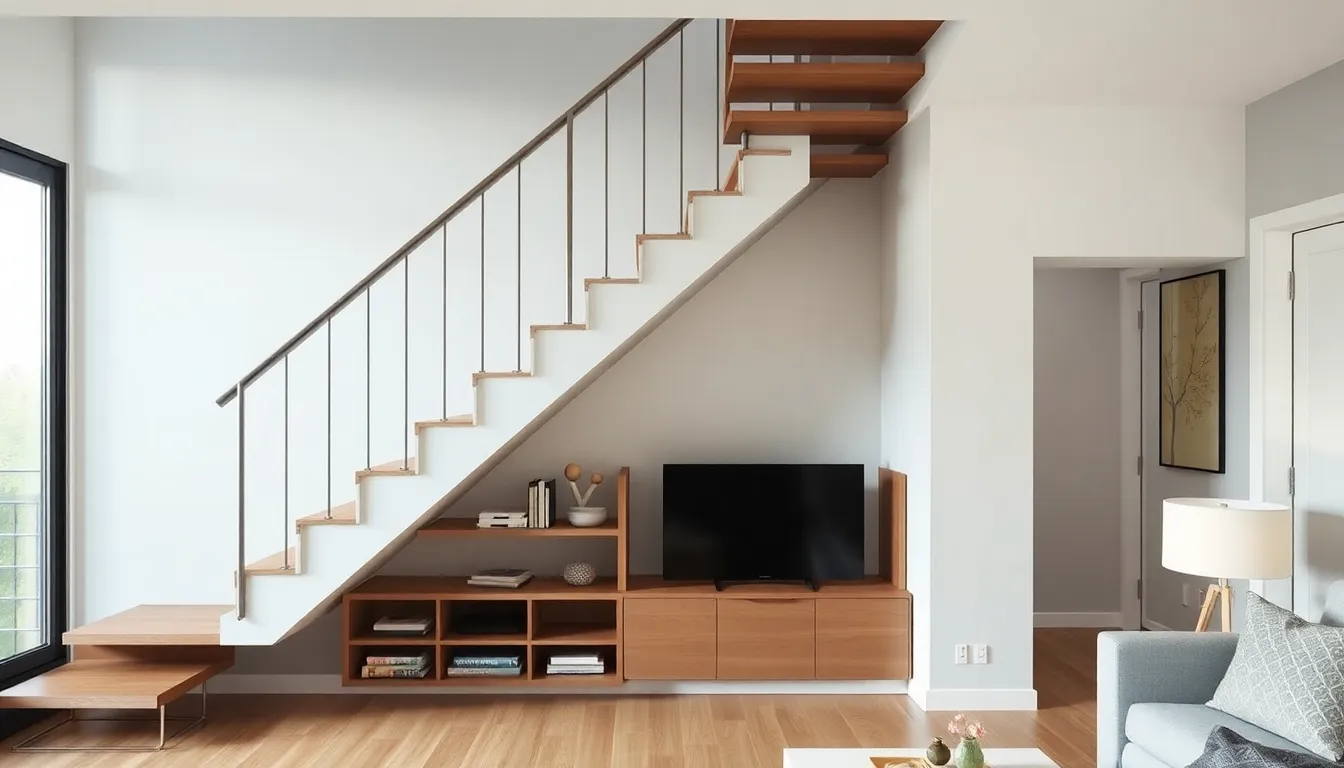
Small spaces demand creative answers that maximize every square foot while maintaining style. We’ve explored how floating staircases excel in compact environments by eliminating bulk and preserving visual openness.
Compact Tread Dimensions
Optimized tread dimensions make floating staircases perfect for tight spaces without sacrificing functionality. We recommend treads measuring 26–30 inches wide and 9–11 inches deep for most compact installations, as these dimensions meet building codes while minimizing the overall footprint. Narrow spiral designs can feature treads as compact as 6–8 inches in depth, though most building codes require minimum depths for safety and comfort.
Steeper configurations save additional floor space when ceiling height allows. We’ve found that slightly steeper angles work well in lofts and modern homes where dramatic vertical movement enhances the architectural appeal. Custom tread sizing helps homeowners achieve the perfect balance between space efficiency and user comfort.
Strategic placement of compact treads creates maximum impact in small rooms. We position these staircases against accent walls or in corners to preserve open floor areas for furniture and daily activities.
Wall-Mounted Support Systems
Structural anchoring eliminates the need for bulky vertical supports by securing treads directly into reinforced walls. We use heavy-duty wall anchors and steel plates embedded within the wall structure to create the true floating effect that small spaces demand. This mounting method keeps the understair area completely open and accessible.
Minimalist hardware maintains clean aesthetics while providing essential support. We install thin metal rods, stainless steel cables, or concealed brackets that support treads from behind or below without visual clutter. These systems keep sightlines clear and preserve the illusion of weightlessness.
Engineering compliance ensures safety without compromising the streamlined appearance. We work with structural engineers to design wall-mounted systems that handle required live loads while meeting local building regulations for handrails and stability.
Multi-Functional Storage Integration
Understair utilization transforms wasted space into valuable storage and functional areas. We design open shelving units, built-in cabinets, or compact seating areas beneath floating staircases to maximize small space efficiency. This approach doubles the functional value of the vertical circulation area.
Built-in drawer systems integrate seamlessly with individual treads for hidden storage answers. We install pull-out drawers beneath each step, creating organized storage for shoes, books, or household items without adding visual bulk to the staircase design.
Modular customization offers flexible answers that adapt to exact small space needs. We specify modular kits and custom designs that allow homeowners to choose storage configurations matching their lifestyle requirements, from wine storage to home office answers.
Luxury Floating Staircase Features
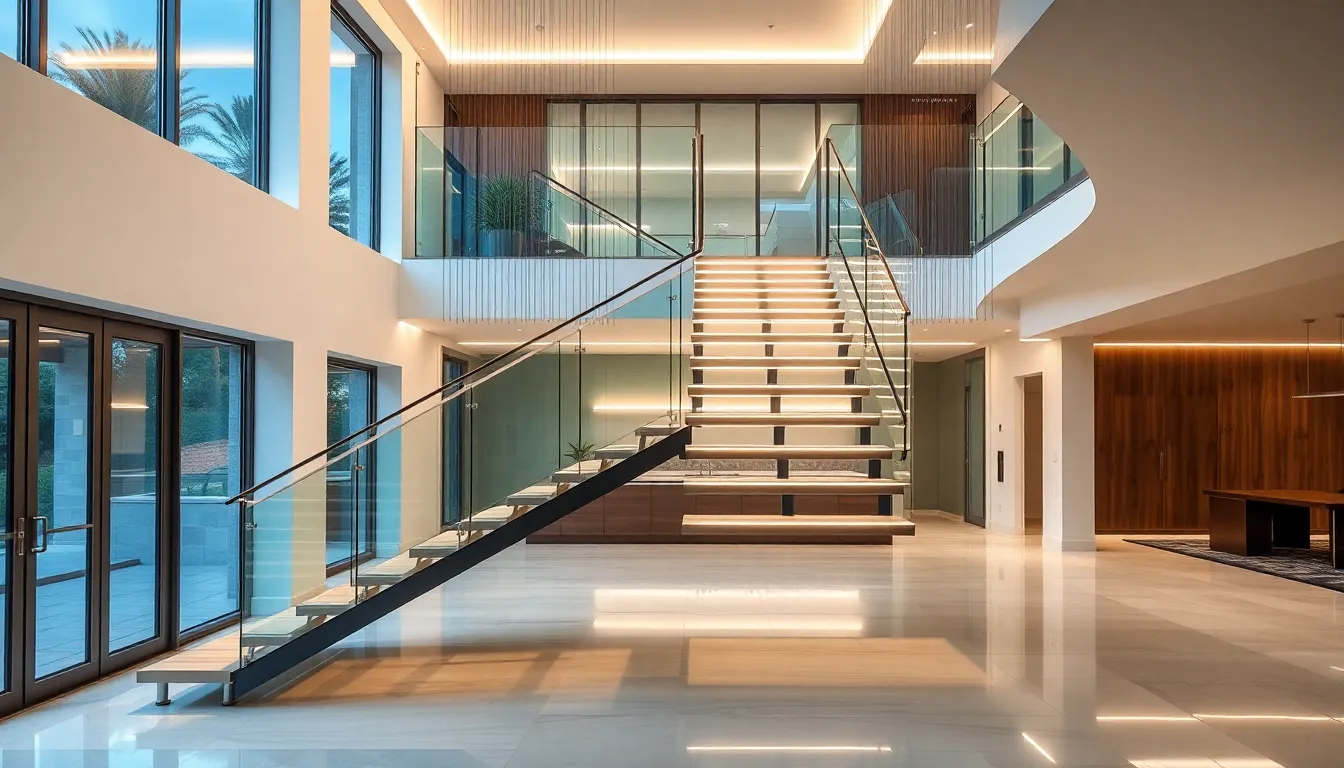
Elevating your floating staircase from functional to fabulous requires careful attention to premium materials and sophisticated design elements. We’ll explore the luxury features that transform ordinary staircases into architectural masterpieces.
Premium Material Combinations
Glass and steel pairings create the ultimate contemporary aesthetic by combining transparent glass railings with sleek steel stringers. This combination maximizes light flow while maintaining structural integrity, making spaces feel larger and more open. We often recommend this pairing for homes with floor to ceiling windows where natural light becomes a design element.
Wood and metal fusion delivers warmth without sacrificing modern appeal through solid wood treads paired with metal stringers. Oak and walnut treads provide durability while steel or aluminum supports offer industrial sophistication. This combination works exceptionally well in transitional spaces that bridge traditional and contemporary design styles.
Marble and stainless steel combinations represent the pinnacle of luxury floating staircase design. Marble treads like Carrara or Calacatta create stunning visual impact while stainless steel stringers provide clean lines and exceptional strength. These materials require professional installation but deliver unmatched elegance that increases property value significantly.
Custom Architectural Details
Zigzag stringers create unique visual interest by incorporating angular patterns that challenge traditional staircase geometry. These custom supports become sculptural elements that draw the eye upward while maintaining structural requirements. We’ve seen zigzag designs work particularly well in modern lofts and contemporary homes with high ceilings.
Double stringer stairs provide enhanced stability and visual weight through paired support beams on either side of the treads. This configuration allows for wider treads and creates a more substantial presence in larger spaces. Double stringers work especially well with heavy materials like thick wood planks or stone treads.
Enclosed stairs with glass panels offer privacy while maintaining the floating aesthetic through transparent or frosted glass enclosures. These designs work perfectly for staircases visible from multiple levels, providing sound dampening without blocking light flow. Solid panel enclosures can incorporate materials like wood veneer or metal mesh for added design flexibility.
Statement Lighting Fixtures
LED strip lighting installation transforms floating staircases into dramatic focal points through strategic placement under treads and along stringers. These systems provide both safety illumination and aesthetic enhancement, creating the illusion that stairs are truly floating on light. Modern LED strips offer dimming capabilities and color changing options for ultimate customization.
Chandelier placement above staircases adds grandeur and emphasizes the vertical drama of floating designs. We recommend oversized fixtures that complement the staircase’s scale, whether that’s a modern geometric pendant or a traditional crystal chandelier. Proper sizing ensures the lighting enhances rather than competes with the staircase’s architectural impact.
Wall mounted accent lights highlight the floating design by casting shadows that emphasize the separation between treads and walls. Recessed wall fixtures, linear LED strips, or artistic sconces can create layered lighting that changes throughout the day. These fixtures work best when coordinated with the staircase’s materials and overall design theme.
Budget-Friendly Floating Staircase Alternatives
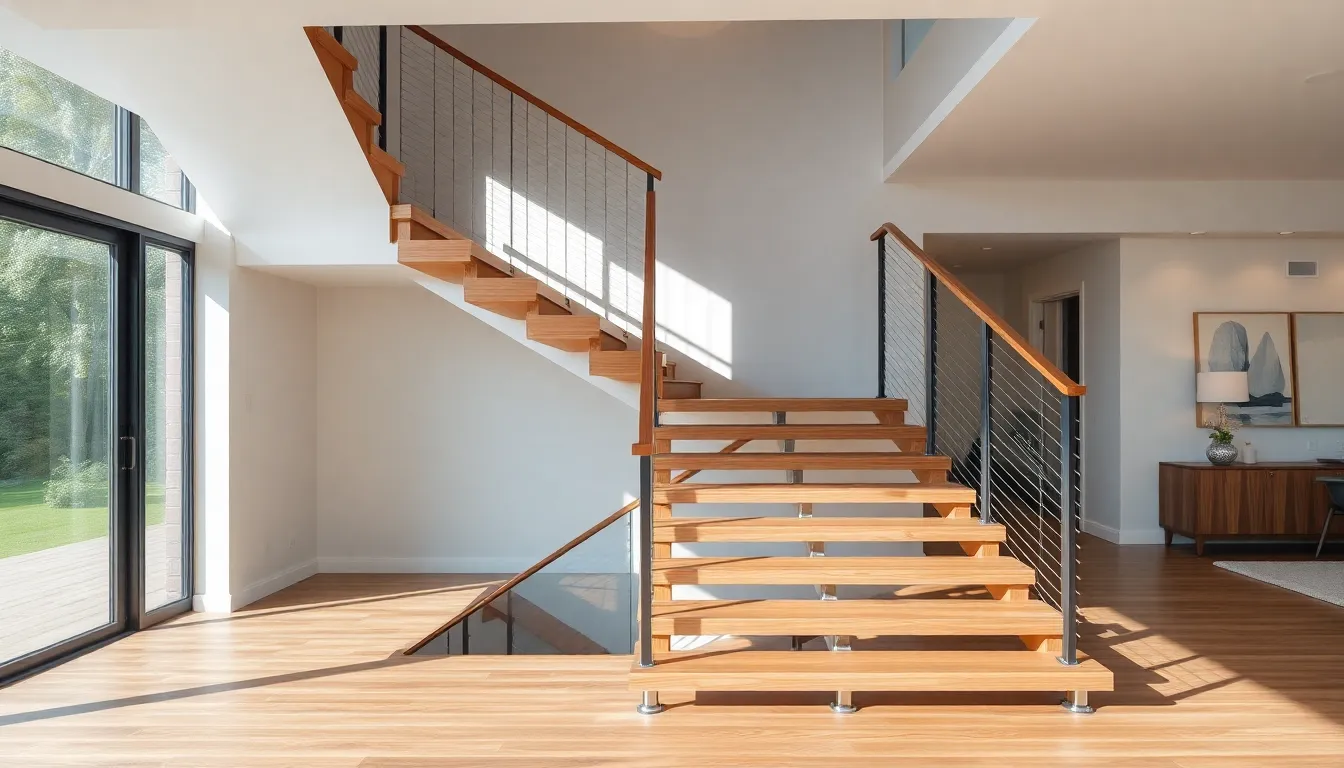
Creating stunning floating staircases doesn’t require very costly. We’ve discovered many ways to achieve the coveted weightless aesthetic while maintaining reasonable costs.
DIY Installation Options
Pre-engineered components make installation surprisingly manageable for skilled homeowners. Companies like Viewrail offer comprehensive installation kits that include all necessary hardware and detailed instructions, reducing professional labor costs significantly. Mono stringer designs simplify the construction process by using a single central support beam instead of complex dual stringer systems.
Prefabricated kits eliminate much of the guesswork in floating staircase construction. These cost-effective answers come with pre-cut components and standardized mounting hardware, making assembly straightforward for DIY enthusiasts. We recommend choosing kits that include wall-mounted brackets and concealed fastening systems to maintain the clean floating appearance.
Wall-mounted bracket systems offer another accessible DIY approach. These systems require basic carpentry skills and standard tools, allowing homeowners to achieve professional results without extensive technical expertise. Hidden support mechanisms integrate seamlessly into drywall construction while providing the structural integrity required by building codes.
Cost-Effective Material Choices
Solid wood delivers classic appeal at affordable price points compared to premium materials. Oak and maple offer excellent durability and natural beauty without the expense of exotic hardwoods or engineered materials. These traditional choices provide warmth and character while maintaining budget consciousness.
Aluminum presents a modern alternative that costs significantly less than stainless steel. This lightweight metal offers corrosion resistance and contemporary aesthetics while reducing both material and installation expenses. We’ve found aluminum treads particularly effective in achieving industrial looks without premium pricing.
Open riser designs reduce material requirements while improving the floating effect. Eliminating solid risers saves on lumber costs and creates better light flow throughout the staircase. This approach maintains structural integrity while reducing overall project expenses by approximately 20-30%.
Combining different materials strategically maximizes visual impact within budget constraints. Mixing wood treads with metal stringers or incorporating glass accents selectively creates sophisticated designs without using expensive materials throughout the entire structure.
Simple Design Approaches
Mono stringer configurations with cable railings achieve clean modern aesthetics efficiently. This streamlined approach uses a single central support beam paired with tensioned cable systems, reducing both material costs and installation complexity. The minimalist design emphasizes the floating effect while maintaining safety standards.
Straight flight designs eliminate the complexity and expense of curved installations. Linear configurations require fewer custom components and simplified engineering, making them ideal for budget-conscious projects. These designs still create dramatic visual impact while keeping costs manageable.
Material mixing strategies allow selective use of premium elements for maximum effect. We recommend incorporating glass or steel accents sparingly while using cost-effective materials like wood for primary structural elements. This approach creates sophisticated contrast without overwhelming the budget.
Wall-mounted support systems eliminate the need for visible structural posts. These hidden mounting answers create true floating appearances while using standard construction techniques and readily available hardware, keeping installation costs reasonable for most homeowners.
Safety Considerations for Floating Staircases
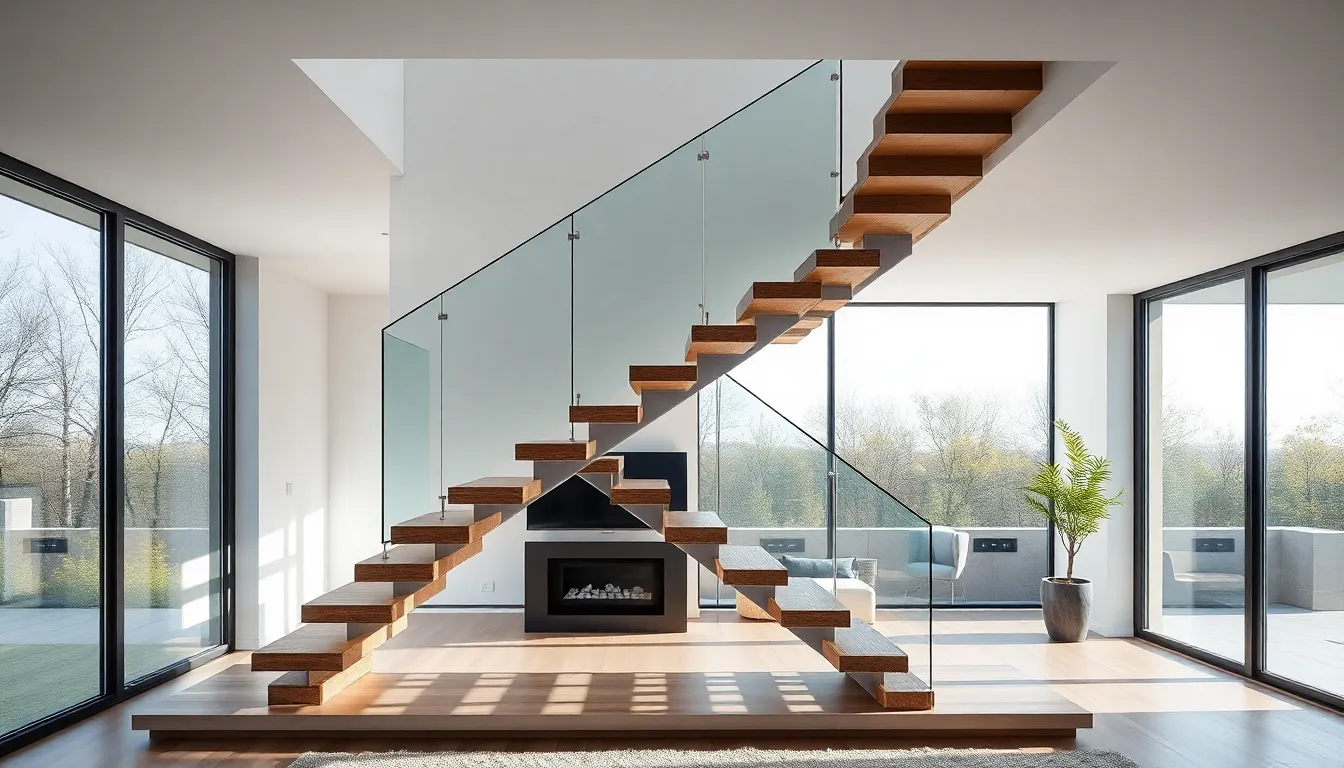
We must prioritize safety when designing floating staircases, as these architectural features require specialized engineering to achieve their stunning weightless appearance. Proper planning and compliance with safety standards ensure that beauty doesn’t compromise functionality.
Building Code Requirements
Building codes dictate exact safety standards that we can’t overlook when installing floating staircases. Local building authorities require minimum tread depth measurements between 10 to 11 inches and maximum riser heights of 7.75 inches to ensure comfortable navigation. We need to verify that our floating staircase design meets load bearing capacity requirements, which typically mandate support for at least 40 pounds per square foot for residential applications.
Railing height requirements specify minimum heights of 36 inches for residential installations and 42 inches for commercial spaces. Building inspectors also require proper anchoring systems that penetrate structural walls or beams by exact depths, usually 6 to 8 inches depending on material composition. We must obtain permits before installation since floating staircases are considered structural modifications that affect building integrity.
Fire safety codes require adequate egress width, typically 36 inches minimum for residential floating staircases. Structural engineers must certify the design calculations to ensure compliance with local building standards before construction begins.
Handrail and Railing Options
Glass railings provide unobstructed views while meeting safety requirements through tempered safety glass panels that resist impact and shattering. We recommend thickness measurements between 1/2 inch to 3/4 inch for residential applications to ensure adequate protection. Stainless steel cable railings offer minimalist aesthetics with horizontal cable runs spaced 4 inches apart maximum to prevent falls.
Metal handrails using materials like brushed aluminum or powder coated steel deliver durability while maintaining the floating illusion. We suggest continuous handrail systems that provide uninterrupted grip surfaces along the entire staircase length. Wall mounted handrails eliminate the need for vertical balusters, preserving clean sight lines while offering essential support.
Combination systems integrate glass panels with metal handrails to maximize both safety and visual appeal. LED integrated railing systems enhance nighttime visibility while adding contemporary flair to the overall design.
Load Bearing Specifications
Structural support systems require robust engineering calculations to ensure floating staircases can handle intended loads without deflection or failure. We anchor steel stringers directly into structural walls using Grade 8 bolts or welded connections that distribute weight across multiple attachment points. Cantilever support calculations must account for ever-changing loads including foot traffic, furniture moving, and emergency situations.
Material selection impacts load bearing capacity significantly, with steel treads supporting heavier loads than wood or glass alternatives. Concrete floating stairs require reinforcement bar integration and proper curing techniques to achieve specified compressive strength ratings. We recommend working with structural engineers who can calculate exact load requirements based on span distances and material specifications.
Wall attachment systems need backing plates or structural mounting points that transfer loads to building framework rather than surface materials. Support beam sizing depends on span length, with longer floating stairs requiring larger structural members to prevent excessive deflection or bounce during use.
Installation Tips for Floating Staircase Projects

Installing a floating staircase requires careful planning and expertise to ensure both safety and aesthetic success. We’ll guide you through the essential steps to transform your vertical space with confidence.
Professional Contractor Selection
Experience with floating staircase installations stands as the most critical factor when choosing your contractor. We recommend seeking professionals who’ve completed at least five similar projects, as floating staircases demand specialized knowledge of cantilever engineering and invisible support systems.
Portfolio reviews reveal the contractor’s design capabilities and craftsmanship quality. Browse their previous floating staircase projects to identify alignment with your aesthetic vision, whether you prefer minimalist steel designs or warm wooden installations.
Client references provide invaluable insights into work quality and project management skills. Contact at least three previous clients to discuss their experience, timeline adherence, and overall satisfaction with the floating staircase installation.
Licensing verification ensures your contractor meets local building requirements and carries proper insurance coverage. We always verify that contractors hold current licenses for structural modifications and specialized staircase installations.
Structural Assessment Requirements
Load bearing capacity evaluation must occur before any floating staircase installation begins. Engineers typically require walls to support 300-500 pounds per linear foot, depending on the staircase design and materials selected.
Building code compliance varies by location but generally mandates minimum tread depths of 10 inches and maximum riser heights of 7.75 inches. We ensure all floating staircase designs meet local residential building codes for safety and legal compliance.
Material selection impacts both structural requirements and aesthetic outcomes. Steel stringers provide maximum strength for longer spans, while wooden treads offer warmth but may require additional support for wider installations.
Foundation analysis determines whether existing floor structures can accommodate the concentrated loads from floating staircase anchor points. Reinforcement may be necessary for optimal safety and stability.
Timeline and Planning Considerations
Design phase allocation typically requires 2-4 weeks for custom floating staircase blueprints and engineering calculations. We allow additional time for design revisions and client approval to ensure complete satisfaction.
Permit acquisition can extend project timelines by 3-6 weeks depending on local building department efficiency. Submit applications early to prevent installation delays, especially for complex floating staircase designs requiring structural modifications.
Installation scheduling depends on contractor availability and project complexity, with most floating staircases requiring 3-5 days for complete installation. Weather conditions affect timeline when materials must be transported through exterior openings.
Material procurement often involves custom fabrication, particularly for unique floating staircase designs using specialized hardware or non standard dimensions. Order materials 4-6 weeks before planned installation to ensure availability.
Conclusion
Floating staircases represent the perfect marriage of form and function in modern home design. Whether you’re drawn to sleek minimalist aesthetics or bold industrial statements these architectural features can transform any space into something extraordinary.
We’ve explored options for every budget and style preference from luxury materials to cost-effective alternatives. The key lies in understanding your space requirements safety considerations and long-term design goals before making your selection.
Remember that successful floating staircase installation requires proper planning professional expertise and attention to building codes. With the right approach you’ll create a stunning focal point that enhances your home’s value while providing years of safe reliable use.
Frequently Asked Questions
What are floating staircases and why are they popular?
Floating staircases are modern architectural features that appear to “float” without visible support structures underneath. They’re popular because they create a sleek, minimalist aesthetic while maximizing natural light flow and making spaces feel larger. Their clean lines and contemporary appeal make them ideal for modern home designs seeking both functionality and visual impact.
What materials are commonly used for floating staircases?
Popular materials include steel and glass for industrial looks, natural wood like oak and walnut for warmth, tempered safety glass for transparency, and acrylic for lightweight options. Many designs combine materials, such as wood with metal supports or glass with steel frameworks, to achieve unique aesthetic and functional benefits.
Are floating staircases safe and up to building codes?
Yes, when properly engineered and installed, floating staircases meet all building code requirements. They require specialized structural support systems, proper load-bearing calculations, and safety features like appropriate tread depths, riser heights, and handrails. Professional installation ensures compliance with local safety standards and building regulations.
Can floating staircases work in small spaces?
Absolutely! Floating staircases are excellent for small spaces because they don’t obstruct light flow and create an illusion of openness. Compact designs include narrower treads, steeper configurations, spiral arrangements, and wall-mounted systems. They can also incorporate storage underneath to maximize functionality in limited square footage.
What’s the cost range for floating staircases?
Costs vary widely based on materials, complexity, and installation requirements. Budget-friendly options include DIY kits and simple wood designs starting around $3,000-$5,000. Mid-range installations typically cost $8,000-$15,000, while luxury custom designs with premium materials can exceed $20,000-$50,000. Professional engineering and installation are additional considerations.
Do floating staircases require special maintenance?
Maintenance requirements depend on materials used. Wood stairs need periodic refinishing and protection from moisture. Glass and acrylic require regular cleaning to maintain transparency. Steel components may need occasional touch-ups to prevent rust. Generally, floating staircases require similar maintenance to traditional stairs, with attention to keeping hardware and mounting points secure.
Can I install a floating staircase myself?
While DIY installation is possible with pre-engineered kits and proper skills, most floating staircases require professional installation due to structural engineering requirements. DIY options work best for simple designs in non-load-bearing situations. Complex installations, custom designs, and structural modifications should always involve qualified contractors and engineers.
What lighting options work best with floating staircases?
LED strip lighting is popular for creating dramatic floating effects while providing safety illumination. Options include under-tread lighting, wall-mounted fixtures, and integrated handrail lighting. Industrial designs often feature Edison bulbs, while luxury installations might include chandeliers or custom fixtures. Proper lighting enhances both aesthetics and safety.

